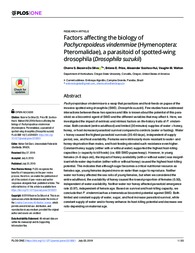Factors affecting the biology of Pachycrepoideus vindemmiae (Hymenoptera: Pteromalidae), a parasitoid of spotted-wing drosophila (Drosophila suzukii).
Factors affecting the biology of Pachycrepoideus vindemmiae (Hymenoptera: Pteromalidae), a parasitoid of spotted-wing drosophila (Drosophila suzukii).
Author(s): SILVA, C. S. B. D.; PRICE, B. E.; SOOHOO-HUI, A.; WALTON, V. M.
Summary: Pachycrepoideus vindemmiae is a wasp that parasitizes and host-feeds on pupae of the invasive spotted-wing drosophila (SWD, Drosophila suzukii). Few studies have addressed interactions between these two species and little is known about the potential of this parasitoid as a biocontrol agent of SWD and the different variables that may affect it. Here, we investigated the impact of extrinsic and intrinsic factors on life-history traits of P. vindemmiae. Both constant (entire adulthood) and limited (30 minutes) supplies of water + honey, honey, or host increased parasitoid survival compared to controls (water or fasting). Water + honey caused the highest parasitoid survivals (35?60 days), independent of supply period, sex, and host availability. Females were intrinsically more resistant to water- and honey-deprivation than males, and host-feeding elevated such resistance even higher. Constant honey supply (either with or without water) supported the highest host-killing capacities (= capacity to kill hosts) (ca. 600 SWD pupae/wasp). However, in young females (4?9 days old), the impact of honey availability (with or without water) was insignificant while water deprivation (either with or without honey) caused the highest host-killing potential. This indicates that although sugar becomes a critical nutritional resource as females age, young females depend more on water than sugar to reproduce. Neither water nor honey affected the sex ratio of young females, but when we considered the entire adulthood, the availability of honey caused the lowest proportion of females (0.50), independent of water availability. Neither water nor honey affected parasitoid emergence rate (0.97), independent of female age. Based on survival and host-killing capacity, we conclude that P. vindemmiae has a tremendous biocontrol potential against SWD. Both limited and constant supply of water, sugar, and host increase parasitoid survival, while constant supply of water and/or honey enhance its host-killing potential and decrease sex ratio depending on maternal age.
Publication year: 2019
Types of publication: Journal article
Unit: Embrapa Cotton
Keywords: Drosophila, Pachycrepoideus vindemmiae, Parasitoids, Water
Observation
Some of Embrapa's publications are published as ePub files. To read them, use or download one of the following free software options to your computer or mobile device. Android: Google Play Books; IOS: iBooks; Windows and Linux: Calibre.
Access other publications
Access the Agricultural Research Database (BDPA) to consult Embrapa's full library collection and records.
Visit Embrapa Bookstore to purchase books and other publications sold by Embrapa.

